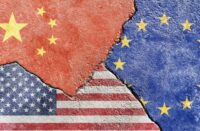On the 17th of February, the Chinese animated film, “Ne Zha 2,” joined the ranks of the top ten highest-grossing films globally, bringing in over $1.66 billion and counting. This success mirrors the worldwide acclaim of the video game, “Black Myth: Wukong.” Both achievements are symbolic of China’s growing cultural influence and increasing soft power.
These triumphs echo powerfully within a nation undergoing a government-led cultural revival, fostering a nationalism centered around culture. By strategically aligning this cultural renaissance with the expansion of soft power, the Chinese government is able to leverage these symbolic victories to enhance its domestic political legitimacy. This balance between global acknowledgment and internal legitimacy will continue to be crucial as China integrates culture into its global strategy.
Despite the Chinese Communist Party (CCP)’s historical campaigns against traditional culture, Xi Jinping’s leadership has positioned culture at the crux of China’s grand revival plan. Xi actively endorses Chinese traditional culture, framing the preservation and development of excellent traditional culture as the party’s mission.
This shift is apparent in the CCP’s evolving ideological framework. Xi’s Thought on Culture was formally introduced during the National Conference on Propaganda, Ideological and Cultural Work in October 2023. Its practical implementation has increasingly emphasized the revival and promotion of traditional Chinese culture over communist ideological narratives.
The popularity of Han clothing (hanfu), especially among the younger generation, exemplifies this growing cultural enthusiasm. In 2023, the number of registered Han clothing-related enterprises in China increased by 355.25 percent year-on-year, with the market size exceeding 14.4 billion yuan. The Chinese Hanfu market is projected to continue to grow, reaching an estimated 24.28 billion yuan by 2027.
This cultural revival also fortifies a nationalism centered around culture, where pride in Chinese heritage increasingly defines national identity. These trends illustrate how cultural nationalism is not merely state-imposed but also reinforced by popular sentiment, shaping both domestic identity and China’s outward projection of soft power.
Simultaneously, China has been actively extending its cultural influence abroad through two main strategies: deepening engagement with international institutions and promoting the global export of cultural products. These efforts are not only aimed at boosting China’s soft power on the world stage but also at reinforcing its great power image domestically.
The export of cultural products also has an economic motivation. The development of China’s cultural industry is also driving the development of related industries, such as cultural tourism, catering, and film and television.
In conclusion, while these cultural exports enhance China’s international image, their greatest impact is within China itself. The CCP strategically presents these successes as validation of China’s civilizational strength, reinforcing domestic nationalism and consolidating its legitimacy.
However, the extent to which China’s cultural diplomacy can garner foreign support remains uncertain. Furthermore, as nationalism continues to rise globally, the spread of Chinese culture abroad may provoke resistance from other nations, potentially leading to barriers for Chinese cultural exports. It is essential for Chinese cultural products to adapt to local markets, rather than solely promoting a one-size-fits-all version of Chinese culture. The success of this strategy will depend on a patient, incremental approach – one that carefully balances material benefits with soft power influence.




